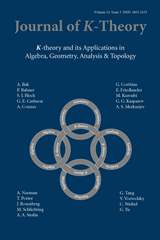No CrossRef data available.
Article contents
Quillen model categories
Published online by Cambridge University Press: 04 March 2013
Abstract
We provide a brief description of the mathematics that led to Daniel Quillen's introduction of model categories, a summary of his seminal work “Homotopical algebra”, and a brief description of some of the developments in the field since.
Keywords
- Type
- Research Article
- Information
- Copyright
- Copyright © ISOPP 2013


